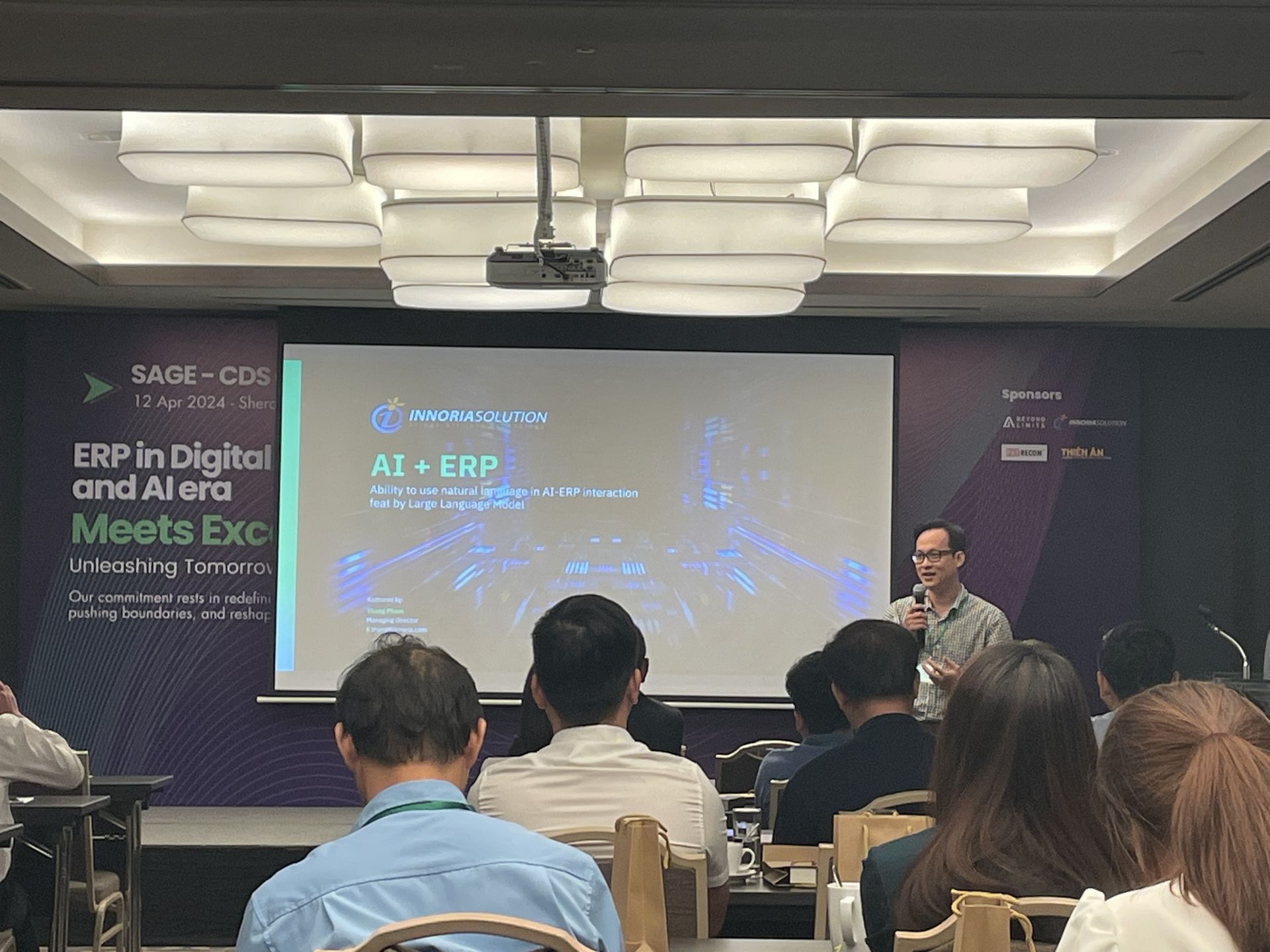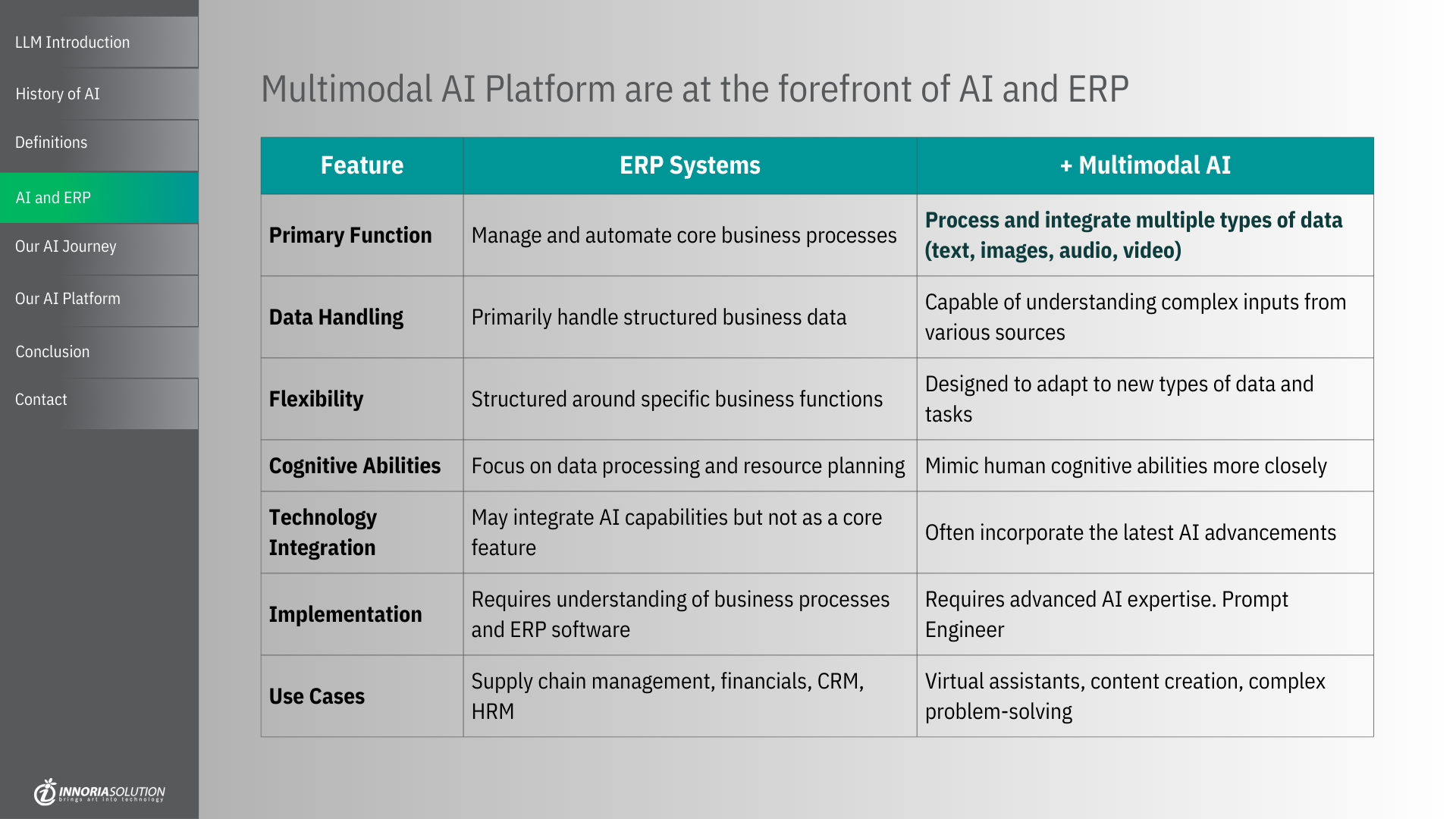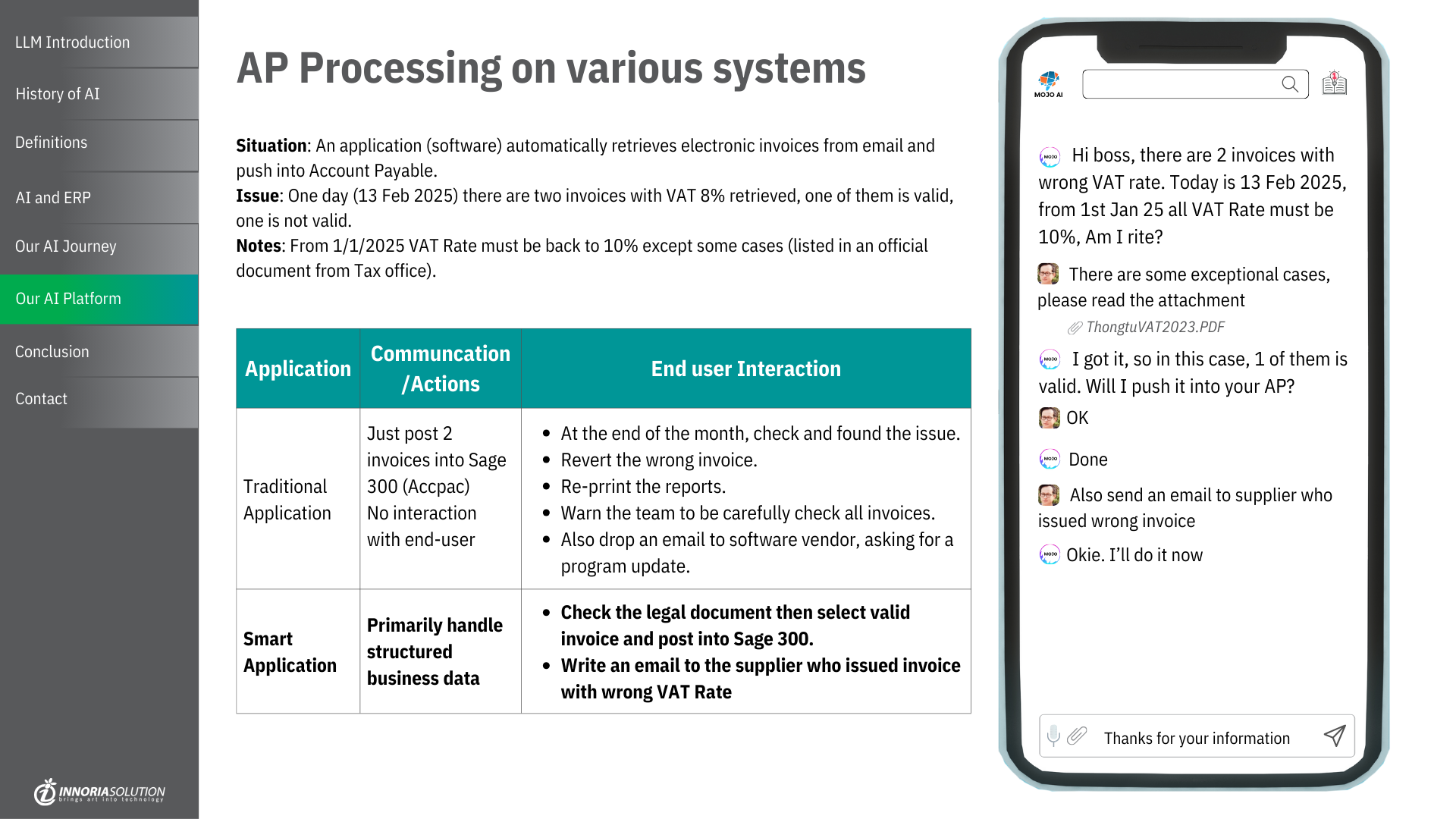On April 12, 2024, the SAGE - CDS Customer Day was hosted at the Sheraton Hotel in District 1, Ho Chi Minh City, Vietnam. The event saw the participation of various manufacturing companies from Vietnam such as Thermtrol, Swarovski, Mobifone MDS, Fumakilla, Viet Thai, Rohto, Khang Truong Thinh coming together to highlight successful business relationships. Attendees were introduced to the features of Sage and its partners, with a special emphasis on Innoria showcasing AI + ERP solutions through the topic of Mojo AI Chatbots.

Mr Thang Pham, Innoria Founder is sharing about the solution, Ability to use natural language in AI-ERP interaction feat by Large Language Model
ERP before and after AI adherence
To discuss the ERP (Enterprise Resource Planning) system before and after the implementation of Artificial Intelligence (AI), you can consider the following points:
Before AI:
- Manual data entry and processing: ERP systems relied heavily on manual data entry and processing, which could be time-consuming and prone to errors.
- Limited automation: Automation in ERP systems was limited, leading to inefficiencies in various processes.
- Decision-making based on historical data: Decisions were primarily based on historical data analysis, which may not always reflect real-time insights.
- Human intervention required: Human intervention was necessary for complex decision-making and problem-solving within the ERP system.
After AI:
- Enhanced automation: AI integration in ERP systems enables enhanced automation of routine tasks, leading to increased efficiency and accuracy.
- Predictive analytics: AI algorithms can analyze real-time data to provide predictive insights for better decision-making.
- Cognitive capabilities: AI-powered ERP systems can learn from data patterns and make intelligent recommendations without human intervention.
- Improved user experience: AI can personalize user experiences within the ERP system, making it more intuitive and user-friendly.
By highlighting these points, you can provide a comprehensive comparison of the ERP system before and after the integration of AI.

Mojo Multimodal AI Platform
With the descriptions above, Thang Pham aim to introduce a direction for building a unique AI service station catering to all ERP needs in the AI era, utilizing multimodal AI platform.
In addition to describing Chatbots using natural language, Plugins, or Workflows, the following components are also crucial and readily supported. To elaborate further on this content, while technical matters may become dry, all the capabilities of an AI Chatbot combined with an ERP system have been pre-designed by us to function almost like a regular employee.
Mojo AI's Knowledge Library technology allows you to upload personalized data, such as files and real-time online data, so that the AI chatbot can seamlessly interact with your own data. After uploading, Mojo AI will automatically segment the documents and deploy searches to retrieve relevant content to answer user queries. For example, you can upload dozens of product document pages into Mojo AI Knowledge for the bot to use, thereby having an exclusive product advisor. You can also add news websites or online articles regularly to Mojo AI's knowledge, and the bot will automatically gather and create the latest information for you.
Regarding Memory capabilities, each chatbot's individual database within Mojo AI will perform semantic matching to assign values to variables identified by user queries and store those values.
Database: Similar to the database function in traditional software development, Mojo's database stores information in a table structure. This approach is suitable for organizing and managing structured data, such as customer information, product lists, order profiles, etc.
Schedule Tasks: Allows users to set up tasks on a schedule during conversations with the bot. For example, when a user clicks on a proposed task in the chat window, the bot will converse with the user to confirm the task and create the task as requested by the user.
With the full methods and features of utilizing multimodal AI platform, Innoria open up limitless yet highly specific possibilities for AI Chatbot and ERP.
AP Processing on various systems
In this scenario, Innoria can observe the difference between traditional ERP, Intelligent ERP with integrated RPA, and ERP integrated with Mojo AI.
1. Traditional ERP:
- Invoices are retrieved from email and directly posted into Sage 300.
- Users (accountants) review invoices at the end of the month and detect errors.
- Incorrect invoices must be reissued, reports adjusted, and the auditing team alerted for thorough invoice checks.
- Emails are sent to the software provider requesting adjustments according to new regulations.
- Dealing with issues in a traditional ERP system is time-consuming and can encounter many problems with new regulations.
2. Intelligent ERP (potentially with RPA integration):
- Alerts are displayed upon detecting issues with tax rates.
- Users review the information and post valid invoices into Sage 300.
- Emails are written to the supplier regarding problematic invoices.
- Intelligent ERP helps control risks and saves time compared to traditional ERP, but may encounter similar issues.
3. ERP integrated with Mojo AI:
- AI detects tax rate issues with invoices and sends information to users via chat.
- Users follow guidance from AI on-screen to address the issue.
- After processing, notifications are sent to managers before invoices are posted into the system.
- Mojo AI learns and remembers from similar situations, aiding in automatic issue resolution and notifying managers only upon completion.
With ERP integrated with Mojo AI, we see perfect collaboration between humans and AI technology. AI helps solve problems quickly and efficiently while learning from experience to improve processing for the future. This saves time and creates a smarter, more flexible, and efficient workflow for businesses.

All already
Based on the learning capability of Artificial Intelligence, an AI tool with an initial basic knowledge base can self-learn (self-study or be taught) to autonomously develop like an employee accumulating experience in the working process.
This makes AI different from traditional software, which is packaged with features upon release and only supplemented with new features through updates from the provider.
Innoria believe that sitting together to listen to the story of your business development and the application of new technology models is something to be done early, based on the achievements that Artificial Intelligence has consistently demonstrated recently.